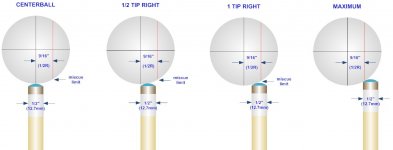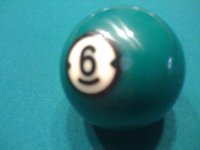Putting the edge of the tip on the CB's centerline means you've moved the shaft sideways only 1/2 tip width.
The actual tip/ball contact point has moved less than that.
pj
chgo
That is correct, and that is the definition that I use. Because to actually move the cue tip one full tip off of the "ghost tip" that is positioned for a centerball hit requires an visual estimation of where the imaginary tip edge is. Even if you are starting at center, picturing that spot on the cueball and then moving the tip.... there is still some guesswork there (unless there is a landmark on the ball that you can reference).
The real rub to all of this discussion is that the discussion itself is completely meaningless due to the fact that people vary their shaft/tip size and tip curvature.
"Tips" themself are not an accurate measurement of sidespin, yet a personal reference point as to how much english that YOU want to apply to the cueball, with whatever starting point that YOU choose.
Chuck



